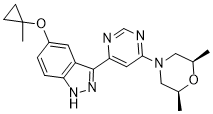All AbMole products are for research use only, cannot be used for human consumption.

MLi-2 is a highly potent, and selective LRRK2 kinase inhibitor with central nervous system activity. MLi-2 exhibits exceptional potency in a purified LRRK2 kinase assay in vitro (IC50 = 0.76 nM), a cellular assay monitoring dephosphorylation of LRRK2 pSer935 LRRK2 (IC50 = 1.4 nM), and a radioligand competition binding assay (IC50 = 3.4 nM). MLi-2 has greater than 295-fold selectivity for over 300 kinases in addition to a diverse panel of receptors and ion channels.
Acute oral and subchronic dosing in MLi-2 mice resulted in dosedependent central and peripheral target inhibition over a 24-hour period as measured by dephosphorylation of pSer935 LRRK2. Treatment of MitoPark mice with MLi-2 is well tolerated over a 15-week period at brain and plasma exposures >100× the in vivo plasma IC50 for LRRK2 kinase inhibition as measured by pSer935 dephosphorylation. Morphologic changes in the lung, consistent with enlarged type II pneumocytes, are observed in MLi-2-treated MitoPark mice.
| Cell Experiment | |
|---|---|
| Cell lines | SH-SY5Y cells |
| Preparation method | A human neuroblastoma cell line, SH-SY5Y, is used for the LRRK2 stable cell line construction. SH-SY5Y cells are cultured in Dulbecco’s modified Eagle’s medium/F-12 supplemented with GlutaMax, 10% tetracycline (Tet)-free fetal bovine serum, nonessential amino acids, pen-strep at 37°C and 5% carbon dioxide. Parental cells are transfected with plasmid constructs that overexpress full-length human LRRK2 wildtype or mutant (G2019S) under the control of a Tet-inducible promoter. Transfected cells are selected and maintained with hygromycin (2 mg/ml) and zeocin (100 mg/ml). Cells are seeded into six-well plates and induced with Tet (2 mg/ml) for 72 hours prior to treatment. After 90 minutes of MLi-2 incubation, cells were mechanically lifted, pelleted, and lysed with lysis buffer supplemented with protease, and phosphatase inhibitors. Pellets are further bead homogenized and then spun at 13,200 rpm for 20 minutes at 4°C. Supernatants are then removed for subsequent Western blot analyses. |
| Concentrations | 10 serial 3-fold dilutions, top concentration 5 μM |
| Incubation time | 90 min |
| Animal Experiment | |
|---|---|
| Animal models | male C57Bl/6 mice weighing 20-25g |
| Formulation | suspended in 30% Captisol |
| Dosages | 1-100 mg/kg; administered in a volume of 10 ml/kg |
| Administration | IV or PO administration |
| Molecular Weight | 379.46 |
| Formula | C21H25N5O2 |
| CAS Number | 1627091-47-7 |
| Solubility (25°C) | DMSO 60 mg/mL |
| Storage |
Powder -20°C 3 years ; 4°C 2 years In solvent -80°C 6 months ; -20°C 1 month |
| Related LRRK2 Products |
|---|
| LRRK2-IN-8
LRRK2-IN-8 is a LRRK2 inhibitor. |
| LRRK2/NUAK1/TYK2-IN-1
LRRK2/NUAK1/TYK2-IN-1 (conpound 226) shows inhibitory activity toward LRRK2 (Wt), LRRK2 (G2019), TYK2 and NUAK1, with IC50 values lower than 10 nM. |
| EB-42486
EB-42486 is a novel potent and highly selective inhibitor of G2019S-LRRK2 (IC50 < 0.2 nM). |
| CZC-54252
CZC-54252 is a potent and selective LRRK2 inhibitor with IC50s of 1.28 nM and 1.85 nM for human wild type LRRK2 and G2019S LRRK2, respectively. |
| WAY-333491
WAY-333491 is a LRRK2 kinase inhibitor. |
All AbMole products are for research use only, cannot be used for human consumption or veterinary use. We do not provide products or services to individuals. Please comply with the intended use and do not use AbMole products for any other purpose.


Products are for research use only. Not for human use. We do not sell to patients.
© Copyright 2010-2024 AbMole BioScience. All Rights Reserved.
